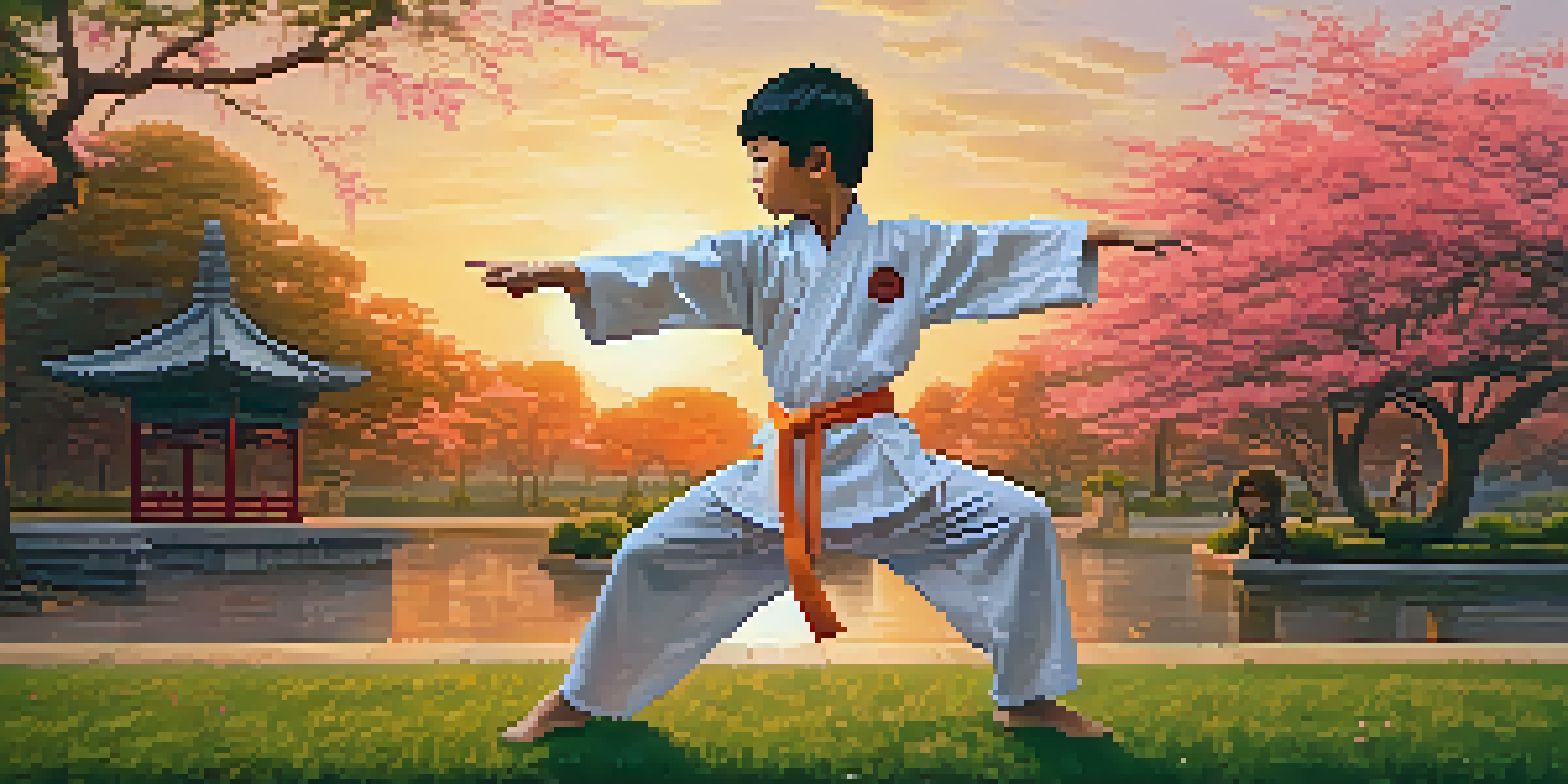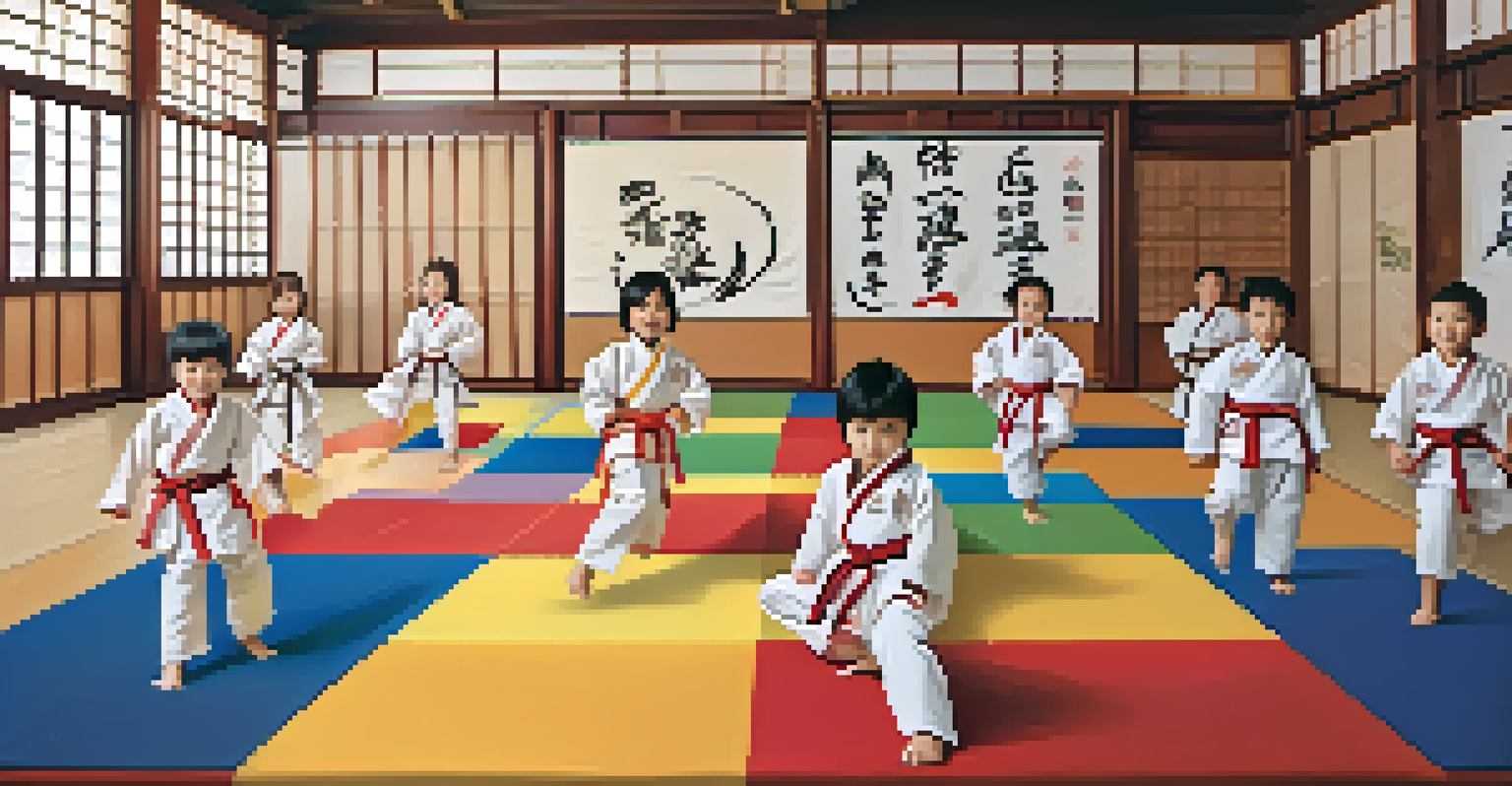Martial Arts in Cartoons: Shaping Youth Perspectives on Combat

The Rising Popularity of Martial Arts in Cartoons
In recent years, martial arts have become a staple in animated series, captivating audiences of all ages. Shows like 'Teenage Mutant Ninja Turtles' and 'Avatar: The Last Airbender' not only entertain but also introduce viewers to various fighting styles. This rise in popularity can be attributed to a growing fascination with martial arts culture, and the desire for engaging storytelling. As these characters face conflicts, they often embody values like discipline and perseverance, which resonate with young viewers.
Martial arts are not about the techniques you learn; they are about the values you embody.
Moreover, the incorporation of martial arts in cartoons allows children to see their favorite characters overcoming challenges through skill and determination. These elements can inspire kids to explore martial arts themselves, sparking interest in classes and competitions. For many, the colorful and dynamic portrayals of martial arts create a sense of excitement that traditional sports may not offer. Ultimately, these shows serve as a gateway for young audiences to learn about martial arts in a fun and accessible way.
However, this popularity also raises questions about the portrayal of violence and conflict resolution. While martial arts can be depicted as a tool for self-defense and empowerment, they can also be misinterpreted as glorifying aggression. It's crucial for parents and educators to engage in conversations with children about what they watch, helping them differentiate between fantasy and real-life ethics surrounding combat.
Character Development Through Martial Arts
Cartoons often use martial arts as a vehicle for character development, showcasing personal growth through training and challenges. Characters like Aang from 'Avatar: The Last Airbender' illustrate how martial arts can teach valuable life lessons, such as balance, respect, and humility. As these characters evolve, they often confront their own fears and insecurities, making their journeys relatable to young audiences. Viewers can see that martial arts is not just about physical prowess but also about mental strength and emotional resilience.

In many cases, the journey to mastery in martial arts is portrayed as a long and arduous process. This narrative can instill a sense of patience and perseverance in children, showing them that success comes from hard work, rather than instant gratification. For instance, watching a character train tirelessly to achieve their goals can inspire viewers to adopt a similar mindset in their pursuits, whether in sports, academics, or personal interests. These lessons extend beyond the screen, encouraging children to embrace challenges in their own lives.
Martial Arts Inspire Personal Growth
Cartoons depict characters overcoming challenges through martial arts, teaching valuable lessons on perseverance and emotional resilience.
Additionally, martial arts-themed cartoons often emphasize teamwork and camaraderie, especially when characters train together or face adversaries as a group. This portrayal fosters a sense of community among viewers, teaching them the importance of collaboration and support. By highlighting these values, cartoons not only entertain but also contribute to the social and emotional development of young audiences.
The Role of Cultural Representation in Martial Arts
Martial arts in cartoons often serve as a lens through which various cultures are represented and celebrated. This representation is vital for fostering understanding and appreciation of different traditions among young audiences. Shows like 'Kung Fu Panda' and 'Jackie Chan Adventures' introduce viewers to the rich histories and philosophies behind martial arts, promoting cultural awareness. By incorporating diverse characters and fighting styles, these cartoons contribute to a more inclusive narrative in children's media.
It’s not about how hard you hit; it’s about how hard you can get hit and keep moving forward.
However, the challenge lies in ensuring that this representation is respectful and accurate. When done right, it can spark curiosity in children, encouraging them to learn more about different cultures and their martial arts practices. For instance, 'Avatar: The Last Airbender' draws from various Asian martial arts and philosophies, allowing children to engage with these concepts in a meaningful way. This exposure can help combat stereotypes and foster a greater sense of empathy and respect for others.
Conversely, misrepresentation or oversimplification can lead to misunderstandings, reinforcing negative stereotypes. It's important for creators to approach cultural elements with sensitivity and research, ensuring that they honor the traditions they depict. As parents and educators, guiding discussions around these representations can help children develop a more nuanced understanding of cultural diversity.
Lessons on Conflict Resolution Through Martial Arts
One of the most significant aspects of martial arts in cartoons is their approach to conflict resolution. Rather than glorifying violence, many shows emphasize the importance of restraint and understanding in combat situations. Characters often face conflicts that require them to choose between fighting and finding peaceful solutions. This narrative can teach young viewers that while martial arts skills can be useful, the ultimate goal is to resolve conflicts without resorting to violence.
For instance, in 'Avatar: The Last Airbender', Aang's journey as the Avatar revolves around his commitment to peace and harmony. He frequently seeks non-violent solutions, illustrating that true strength lies in compassion and empathy. Such portrayals can help children understand that conflicts can often be resolved through dialogue and understanding instead of fists. This message resonates deeply in a world where conflict resolution skills are increasingly important.
Cultural Representation Matters
Martial arts in cartoons promote cultural understanding, but creators must ensure respectful and accurate portrayals to avoid reinforcing stereotypes.
Moreover, these cartoons often showcase the consequences of violence, teaching children that physical confrontations can lead to unintended outcomes. By highlighting the emotional and physical toll of fighting, creators encourage viewers to think critically about their actions. As children absorb these lessons, they can develop a more profound sense of responsibility when it comes to handling conflicts in their own lives.
Physical Fitness and Health Benefits of Martial Arts
Martial arts-themed cartoons often highlight the physical fitness and health benefits associated with training. Characters are frequently depicted engaging in rigorous training regimens, which can inspire young viewers to adopt a more active lifestyle. The dynamic moves and acrobatic feats showcased in these shows can spark interest in martial arts classes or other physical activities, promoting overall health and well-being. By associating martial arts with fun and excitement, these cartoons present fitness as an enjoyable pursuit.
Additionally, martial arts training is known for improving flexibility, strength, and coordination. Young viewers who are captivated by their favorite characters' athleticism may be motivated to try out martial arts for themselves. This can lead to increased self-esteem and confidence as children learn new skills and challenge themselves physically. The positive portrayal of physical activity in cartoons can be a powerful motivator for children to get off the couch and engage in sports or martial arts.
Moreover, martial arts training offers mental benefits as well, such as improved focus and discipline. Cartoons that depict characters mastering their techniques often emphasize the importance of concentration and dedication. By showcasing these attributes, creators can encourage children to develop a growth mindset, helping them understand that effort and persistence lead to improvement. These messages can be especially valuable in fostering resilience in young viewers.
Empowerment and Self-Defense Through Martial Arts
A prominent theme in martial arts cartoons is empowerment through self-defense. Characters often begin their journeys as underdogs who must learn to stand up for themselves and others. This narrative not only entertains but also provides a framework for children to understand personal safety and the importance of self-defense. By showcasing characters who gain confidence and strength through martial arts training, these shows can inspire young viewers to feel empowered in their own lives.
Moreover, the portrayal of martial arts as a means of self-defense reinforces the idea that it can be a valuable skill for everyone, regardless of size or gender. For instance, in 'Kim Possible,' the protagonist uses her martial arts skills to navigate various challenges and adversaries. This representation can help break down stereotypes about who can practice martial arts and encourage a diverse range of children to explore these disciplines. It sends a powerful message that strength comes in many forms.
Conflict Resolution Through Empathy
Many animated series emphasize resolving conflicts peacefully, illustrating that true strength lies in compassion and understanding rather than violence.
It's important to note, however, that while martial arts can empower individuals, they should always be approached with a focus on responsibility. Cartoons that illustrate the consequences of misuse—such as using skills for bullying—can reinforce the idea that self-defense should always be exercised judiciously. These narratives can help children understand that true empowerment comes from using their skills to protect themselves and others rather than to instigate conflict.
The Future of Martial Arts in Children’s Cartoons
As animation continues to evolve, the representation of martial arts in children's cartoons is likely to grow in complexity and depth. With a greater emphasis on storytelling and character development, we can expect future shows to explore even more nuanced themes related to martial arts. This evolution could lead to richer narratives that delve into the historical, cultural, and philosophical aspects of various martial arts, providing young viewers with a more comprehensive understanding of these practices.
Furthermore, as awareness of diversity and inclusion increases, we may see more characters from varied backgrounds engaging in martial arts. This could contribute to a more balanced narrative that celebrates different fighting styles and philosophies, while also addressing relevant social issues. By incorporating diverse characters and experiences, creators can enrich the conversation around martial arts, making it relevant to a broader audience.

Finally, the integration of technology and interactive storytelling could also shape the future of martial arts in cartoons. As children engage with digital platforms, there may be opportunities to create interactive experiences that allow them to learn martial arts techniques or engage in virtual training sessions. This could further enhance their interest and appreciation for martial arts, ensuring that the lessons learned from their favorite cartoons translate into real-life experiences.